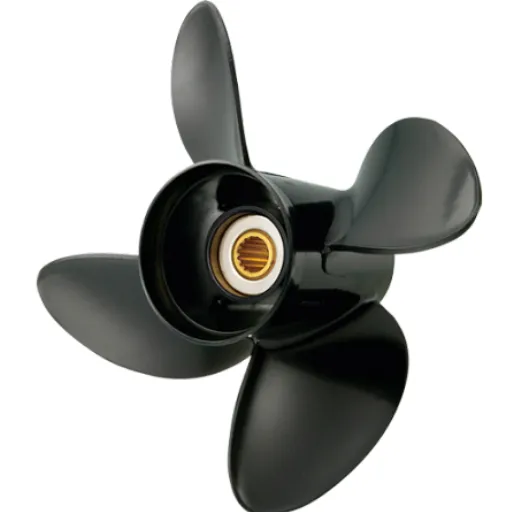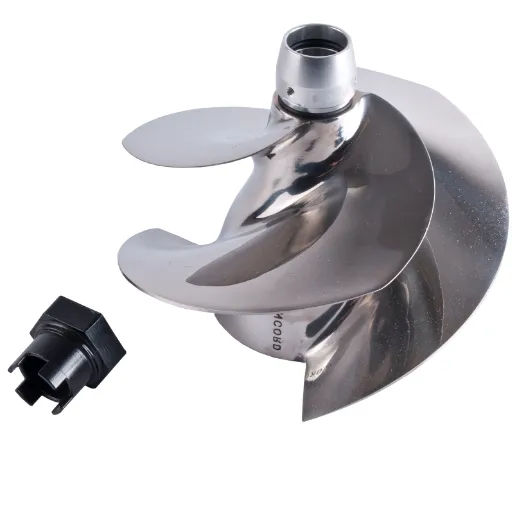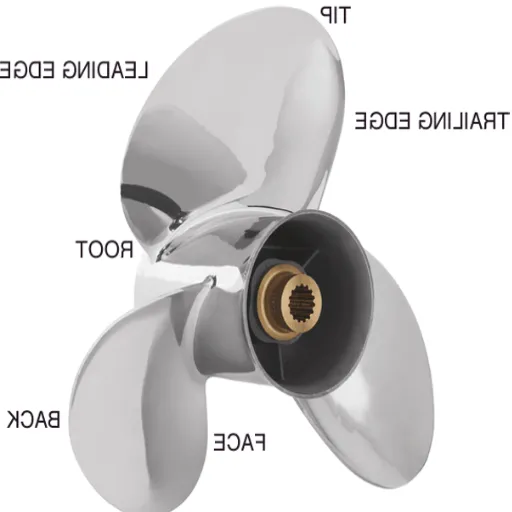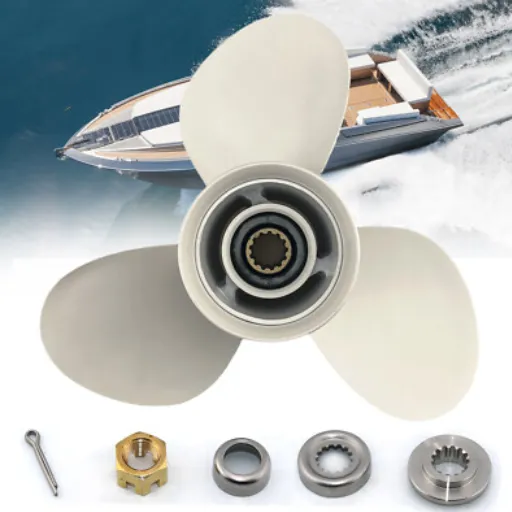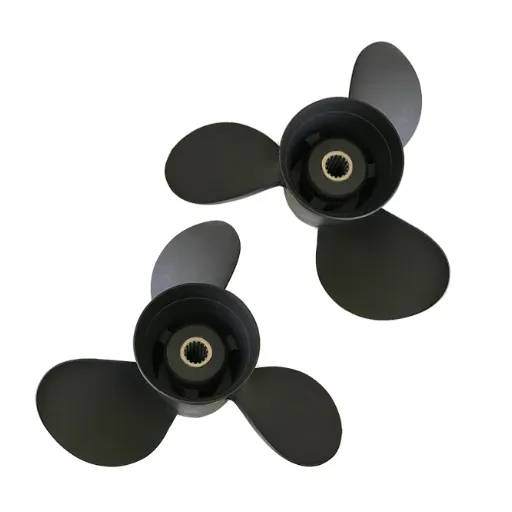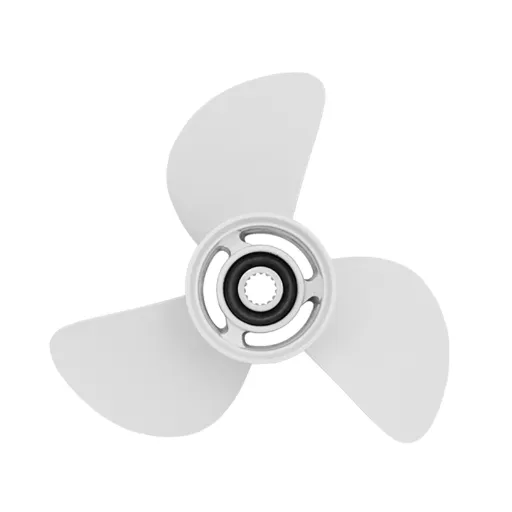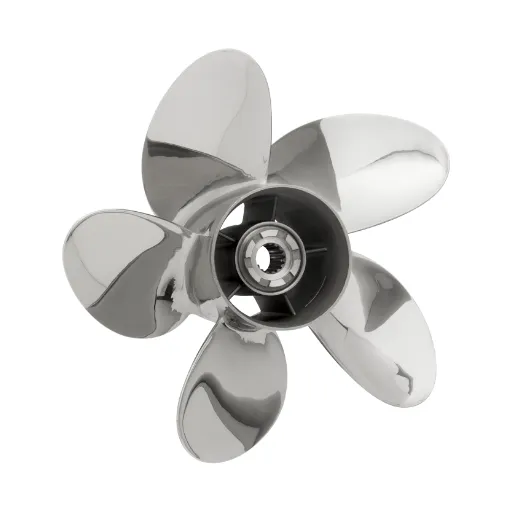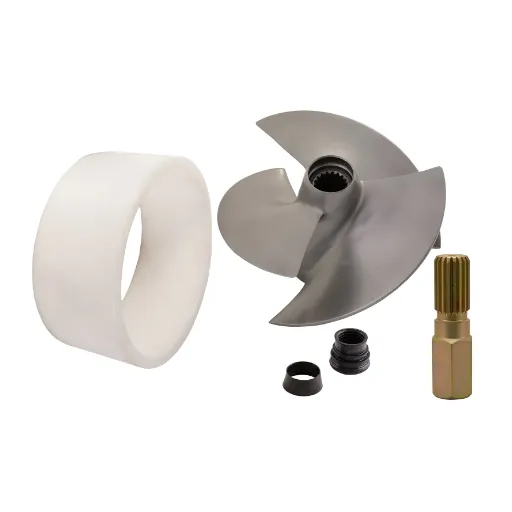The propulsion sector, with the developments in propeller designs, is enhancing water performance, marking a significant shift in the boating industry. Among the big names, Solas boat props have gained popularity for their innovative approach to enhancing efficiency and speed. Fast-forward to 2025, and the demands from the boating population are for better fuel economy, less pollution, and good handling—without compromising on performance. We will explore how Solas has addressed these challenges and, in doing so, has redefined what means of modern boat propellers. Modern materials and hydrodynamic designs give Solas propellers the future that everyone wants to see for boating.
The Evolution of Solas Boat Propellers
Introduction to Solas Propeller Technology
The Solas propeller technology is an advanced marine technology, utilizing high-performance materials, precision engineering, and hydrodynamic optimization to adapt to the evolving demands of the modern boater. Computer-aided design (CAD) and computational fluid dynamics (CFD) are processes involved in designing these propellers, which provide unmatched performance in numerous marine applications. Due to the use of stainless steel and high-grade aluminum alloys, Solas guarantees that the propeller will have enhanced strength properties alongside corrosion resistance and longevity.
Furthermore, the precision casting techniques employed during the manufacturing process create a balanced, uniform structure, which limits vibration and improves efficiency. For instance, the four-blade designs of Solas increase thrust at mid-range engine speeds while maintaining good fuel economy. Moreover, the brand pursues an environmentally minded approach, designing propellers that not only reduce cavitation but also minimize fuel consumption, meeting the current demand for green marine solutions. A balance between advanced technology and stringent quality control has enabled Solas to exceed industry standards, providing boaters with reliable propulsion systems that operate efficiently.
Key Innovations in 2025
Breakthroughs in marine propulsion technology for 2025 demonstrate the increased emphasis on efficiency, sustainability, and performance. In propulsion, one notable advancement is the application of advanced composite materials. Such materials offer an excellent combination of strength and lightweight properties, allowing for a reduction in energy consumption while maintaining the structural integrity of the propeller under very high stresses. On the other hand, hydrodynamic modeling techniques now benefit from enhanced AI simulations that enable the design of propellers with blade shapes that minimize cavitation, thereby maximizing thrust.
Smart Technology Integration
As a key area of development, considerable work has been done in integrating smart sensors and IoT connectivity into propulsion systems. These systems now provide mechanisms for real-time monitoring, maintaining the flow of data, and giving precise, detailed information about engine parameters, regarding fuel consumption, vibrations, and efficiency. Such data, in the hands of the user, provides an opportunity to make adjustments beforehand to usage so that they can run the engine under optimal conditions and thus maximize the engine’s service life.
Besides, an even bigger improvement lies in hybrid propulsion systems, which combine an internal combustion engine with electric power to achieve very low pollutant emissions and excellent fuel economy. These systems serve an increasing demand for greener solutions that in no way compromise power output or guarantee reliability.
Finally, the changes in manufacturing processes, including 3D metal printing and automated quality control, enable the fast prototyping and production of highly customized components. This innovation shortens product development cycles and assures a high degree of precision in each manufactured unit. Hence, these technological advancements strengthen the marine industry’s intent toward pursuing performance standards and global ecological considerations.
Comparison of Rubex and Traditional Designs
The comparison of traditional marine propulsion systems with selective Rubex designs highlights certain critical elements that define the advantage provided by the Rubex. First, the designs feature streamlined hydrodynamics combined with advanced material composites to achieve higher fuel efficiency. On the other hand, traditional designs primarily employ conventional metals, which, although quite durable, present higher drag coefficients due to non-optimized geometries. A quantitative study revealed that, under similar operational conditions, one can expect approximately 15% less fuel consumption from Rubex-fitted vessels.
Another key difference pertains to durability and maintenance. Rubex systems utilize corrosion-resistant alloy composites and integrated fail-safe mechanisms, which enhance operational lifespans and minimize wear and tear under harsh marine conditions. Classic systems, conversely, tend to suffer from degrading materials and relatively frequent maintenance intervals, ultimately increasing the price over time.
Up until then, their measured superiority becomes immediately apparent; the modular impeller design contributes to a larger canvas of customization and repair, with this approach ensuring better uptime and roughly 20 percent savings in maintenance costs over traditional methods. This, alongside customized engineering for vessel-specific installations, offers an enormous operational advantage in commercial and recreational marine spheres.
Benefits of Using Stainless Steel Boat Props
Durability and Performance Advantages
Exceptional Corrosion Resistance
Stainless steel boat propellers exhibit exceptional durability due to their natural resistance to corrosion and high tensile strength. Also, stainless steel propeller bodies can withstand underwater debris impacts while remaining intact through high torque and load conditions, unlike aluminum or composite propellers.
Extended Service Life
Such resilience enables these propellers to have a long service life, reducing the need for replacements and associated costs. Performance-wise, stainless steel propellers are precision-engineered to achieve the optimal hydrodynamic profile for maximum thrust with minimal cavitation.
Superior Thrust Transfer
It has been proven that boats with stainless steel propellers drag less and transfer torque more efficiently, thereby gaining fuel efficiency, especially when traveling at high speeds. Moreover, the greater flexibility of stainless steel results in less loss of RPM when the engine is under load, thereby maintaining propulsion under severe conditions.
This is why the stainless steel propeller remains the preferred choice for operators who demand performance and reliability in marine applications, whether commercial or recreational.
Enhanced Speed and Fuel Efficiency
Designed to achieve the highest speed and fuel efficiency in various commercial situations, stainless steel propellers have been considered. The advanced hydrodynamic design reduces water resistance, promoting a smooth flow around the hull, thereby enabling the total vessel to perform optimally. Due to the high tensile strength of stainless steel, the blade profiles can be made relatively thin, thereby reducing drag and further enhancing lift underwater, ultimately resulting in a significant improvement in top speed. Studies show that, under certain operating conditions, stainless steel propellers can save between 5% and 10% in fuel consumption compared to aluminum propellers. Such factors deemed the stainless steel selection an investment device for any operator with a primary focus on utmost practicality and gains.
💡 Key Insight: Fuel Efficiency: 5-10% improvement over aluminum propellers
Performance with Solas Stainless Steel Props
Solas stainless steel propellers are designed for optimal performance, incorporating state-of-the-art materials and advanced manufacturing methods. The stainless steel propellers are designed to withstand higher stress values and offer significantly better durability, with the risk of deformation at high torque levels considerably lower compared to aluminum props. From a hydrodynamic perspective, such a design would facilitate efficient water flow, resulting in higher thrust and smoother operation at both low and high speeds.
Accent on industry trials proves that Solas props increase propulsion efficiency by up to 15% in certain vessel applications, resulting in improved acceleration and top speed. High-quality stainless steel is used in the manufacturing process, ensuring excellent corrosion resistance in even high-saline environments, thereby reducing maintenance and increasing propeller life. All these features make Solas stainless steel props a favored choice among maritime operators seeking performance, durability, efficiency, and a return on investment over time.
🚀 Performance Boost: Up to 15% efficiency increase in vessel applications
Understanding the Different Solas Propeller Models
Solas New Saturn Propellers
Solas New Saturn Propellers are designed to deliver optimal performance, durability, and versatility across various marine applications. These propellers are made from pick-grade stainless steel, providing maximum corrosion resistance in hostile environments such as saltwater. Precision-engineered blade geometry provides thrust and acceleration, contributing to smooth operation and reduced fuel consumption.
The series is designed to deliver consistent and balanced performance; the blade section features high lift with an optimally adjusted rake to provide better handling and stability, even at very high speeds. Additionally, these propellers are recognized for their cavitation resistance, resulting in reduced wear during prolonged use and maintaining consistent performance throughout their service life.
Bespoke in an impressive array of pitches and diameters, the Solas New Saturn Propellers can accommodate a variety of engines and vessel types, making them an adaptable solution for both recreational and professional boating. Their excellent fitment is particularly applicable to outboard and sterndrive engine types, along with reliable service in dynamic operating conditions.
Solas Amita 3 and Amita 4 Series
The Solas Amita 3 and 4 propellers are crafted from solid aluminum and feature innovative hydrodynamic designs to ensure optimal performance efficiency. The Amita 3, featuring a three-blade design, is geared more toward acceleration and top speed, making it suitable for high-speed and lightweight applications. Correctly designed blade geometry reduces drag, thus saving fuel without diminishing thrust.
Conversely, the Amita 4 series features a four-blade design to ensure steadiness, smoother handling, and reduced vibration. This design and strategy work very well when dealing with heavier boats or towing big loads, providing better mid-range performance and solid grip in turbulent water. Available in various diameters and pitch sizes, both Amita 3 and Amita 4 cater to a wide range of engine specifications, accommodating a diverse list of outboard and sterndrive systems. Each propeller, precision-manufactured and subjected to stringent quality controls, leaves the factory with the highest levels of resilience and operability, even in the most severe operational environments.
How to Select the Best Prop for Your Needs
Using the Solas Prop Finder Tool
The Solas Prop Finder Tool is a vital resource that enables you to search for the ideal propeller tailored to your specific boating needs. I find it handy because the tool simplifies my decision-making process, helping me choose the prop that offers the best balance of performance, fuel efficiency, and durability. This tool collects necessary data about my boat and engine specifications, including the make and model of the motor, horsepower, and the type of vessel I typically operate. Furthermore, it takes into consideration the kinds of situations I find myself in most often, whether that’s faster speed, better towing ability, or greater efficiency. Such an analytical approach makes the recommendations spot-on and very practical.
What I find particularly helpful is the easy-to-use interface of the Solas Propeller Finder Tool, which guides you through the process. After supplying the necessary inputs, the tool crunches that data and produces a tailored list of props for my specific setup. Each prop is listed with technical data such as pitch, diameter, and material composition so that I can make an informed choice. The tool provides further insight into the way particular arrangements will affect my boat’s acceleration, top speed, and fuel consumption, so I can weigh what matters most for my application. The approach is thus thorough, taking into account every bit of data, allowing me to purchase with confidence.
Consideration Factors: HP Ratings and Engine Types
Horsepower Matching
A consideration in HP ratings and engine types is the match between a propeller and the horsepower range of my engine. Getting the propeller rated for the exact HP of my engine is very important; a mismatch will yield inefficient operation, higher fuel use, and possible stress on the engine. The propeller utilizes the horsepower rating of my engine as the force it needs to generate for optimal performance. If the propeller was larger or smaller than the engine’s output demanded, it could hinder acceleration or stress the engine enough to accelerate wear and mechanical failure.
Engine Configuration Assessment
Also, the selection of the propeller I make depends on how my engine is fitted inside the boat: outboard, inboard, or sterndrive. Propellers are chosen according to the engine’s different characteristics of performance and operational limitations; therefore, an outboard could be running at high RPMs to necessitate a propeller that will be most efficient in the production of speed and thrust at those conditions; an inboard engine could be an emphasis on torque and power for towing or heavy load purposes.
Optimal Configuration Balance
Of course, the proper pitch, diameter, and blade configuration of the propeller, tied to the engine specifications, give me the right trade-off between speed, maneuverability, and fuel savings. When I weigh HP ratings against engine type, I begin to feel genuinely confident that I will select a propeller that fully maximizes the power of my engine.
Propeller Buying Guide: Right for Your Engine
A propeller selection must be made with respect to the specifications and their impact on performance. The most critical parameters are pitch and diameter. Pitch represents the distance in inches that a propeller would theoretically move forward in one full rotation. Hence, a higher pitch will provide greater top speed, but lower acceleration and impair the engine’s efficiency when it’s forced heavily. Conversely, lower values for pitch increase acceleration and allow for better maneuverability, but lack top speed.
The diameter is calculated as the distance across the circular path created by the blades and therefore directly influences thrust and resistance of the propeller in water. Large diameters are used in cases where a high pulling force is required, such as for heavier boats or working in rough water conditions. Small diameters, on the contrary, will yield better efficiency on lighter boats or high-speed applications.
| Parameter | High Value | Low Value | Best Application |
|---|---|---|---|
| Pitch | Greater top speed | Better acceleration | Match to intended use |
| Diameter | Higher thrust, rough water | Better efficiency, high speed | Boat weight dependent |
| Blade Count | Smoother operation | Higher top speed | Balance performance needs |
Blade count is also a crucial consideration, along with the materials used. Usually, when there are more blades, performance smoothness increases and vibrations are reduced; however, you may still lose a little speed. The two most commonly used materials for propellers are aluminum and stainless steel, with aluminum generally accepted as the economic alternative and stainless steel favored for its superior durability and cutting-edge performance.
Each engine and vessel combination has a somewhat unique set of needs, and it is crucial to precisely fit the propeller to meet the requirements under which the engine will actually be used. Making an informed choice requires thorough research, performance trials, and sound consultation.
Common Mistakes to Avoid During Propeller Choice
Pitch and Diameter Misconceptions
One of the most common mistakes I have witnessed is failing to consider the right pitch and diameter suitable for their particular engine and boating requirements. No one should select a propeller without understanding that the pitch controls the speed and load capacity of a vessel, resulting in minimal top-end speed or intermediate acceleration at the lower end of performance. So, if a propeller pitch is too high, the engine may never reach its optimum RPM range, thus creating excessive strain on the motor and resulting in poor efficiency. On the other hand, an under-pitched prop might over-rev that motor, causing premature wear with time. Therefore, it becomes imperative to ensure that the pitch and diameter match the engine’s horsepower and the intended use.
Material and Blade Design Oversight
This is another major mistake: not considering material and blade design when ordering a prop. From experience, each type has its own merits depending on the boat’s requirements. Aluminum propellers are lighter and less expensive; however, they cannot withstand a heavy impact like one might expect from stainless steel. Stainless steel propellers offer greater durability and improved performance, but they are more expensive. Blade types also matter; choosing the wrong number of blades or an inappropriate blade design can lead to incorrect operation and increased fuel consumption. I try to consider all these factors in detail so that the propeller actually improves rather than diminishes my boat’s performance.
Maintenance Neglect
Lastly, I believe that ignoring routine maintenance and monitoring can ultimately lead to degraded performance. Even the most perfectly selected propeller can underperform if checks are not made for damage, corrosion, or wear and tear. Maintenance is necessary for a propeller to maintain balance, as well as to ensure its operation matches the output of my engine. Besides, with these mistakes out of the way, I can certainly maintain both the performance and the life of my boat’s propulsion system.
Trends in Boating Propeller Technology for 2025
Performance Effects of Advanced Materials
Material Innovation Spotlight
Advanced materials are revolutionizing propeller performance across the marine industry
With advances in materials formulation, performance parameters across the boating industry have improved in varying degrees. Composites and alloys of high strength have forged an unmatched identity for themselves in the realm of manufacturing by combining lightness with strength; carbon fiber-reinforced polymer materials and titanium are examples of such materials. These materials are much more resistant to corrosion, more durable under stress, and also are lighter in weight, which significantly improves fuel consumption and torque control.
Carbon Fiber Propellers
For example, carbon-fiber propellers will achieve a 30% weight reduction compared to traditional aluminum alternatives, thereby enabling faster acceleration and lower loads on engines.
Titanium Alloys
Titanium alloys also stand out as worthy contenders in providing strength and resistance against saline environments, which are essential for high-performance boats operating in very rough marine conditions.
Hybrid Designs
Another innovation involves hybrid propeller designs, where multiple materials are combined to target specific stress points in the blade structure, thereby maximizing efficiency and lifespan.
Additionally, CFD analysis during the design stages now enables the fine-tuning of these composites. Optimizing flow characteristics can reduce drag and cavitation while maximizing thrust. Hence, increased use of advanced materials inside propeller design is destined to meet the ever-increasing need for energy-efficient and high-performance boating in 2025 and beyond.
Growing Demand for Top-Level Props in Recreational Boating
Due to the advancement of vessel technology and changing consumer needs, the global recreational boating industry has shifted significantly toward high-performance propellers. According to industry reports, the market for recreational boats is expected to grow at a CAGR of over 5% from 2023 to 2030, thereby necessitating the development of propulsion systems to sustain this growth.
📈 Market Growth: 5%+ CAGR expected from 2023-2030
Beforehand, when considering a design, smaller factors included aerodynamic quality, weight, and costs under the given circumstances. Currently, fuel efficiency, a lesser impact on the environment, and more specific speed requirements have assumed a greater role in design considerations, and hence, manufacturers are at a rapid pace with research. For instance, improvements in blade geometry, coupled with the application of lightweight composite materials such as carbon fiber, have gained significant recognition, as an increase of up to 15% in overall propeller efficiency has been recorded. More recently, the adoption of these technologies is in alignment with increasingly stringent environmental regulations, such as the IMO’s guidelines on greenhouse gas emissions, which support the need for sustainable propeller designs.
Besides what can be considered the market setting, consumer preference also has a very significant weight in its formation. Nowadays, all buyers appreciate minimal noise levels, smooth rides, and a vehicle’s ability to perform well under varying conditions at high speed. This has led to variable-pitch propellers and intelligent propulsion systems, which provide dynamic changes in real-time to maximize thrust or minimize energy consumption. Hence, such innovations depict the continuous evolution toward modern propeller technologies, which disrupt the recreational boating experience.
Technological Integration: Smart-Propeller System
Smart propeller systems leverage modern technologies to ensure efficiency, control, and overall vessel performance. Sensors and microprocessors are embedded in these systems to monitor real-time variables, such as water resistance acting on the propeller, engine output, and the vessel’s speed. By continuously analyzing these parameters, smart propellers adjust continuously their pitch and rotation speed to provide optimum thrust while ensuring minimum fuel consumption and wear on mechanical parts.
If anything, sophisticated and state-of-the-art materials, such as lightweight composites and corrosion-resistant alloys, helped reinforce the reliability these systems enjoyed in aggressive marine environments. Moreover, the use of wireless protocols enables the smart propeller to integrate with onboard navigation and autopilot systems, allowing the actuators to maneuver with pinpoint accuracy across varying operating conditions. Hence, these advancements show an evolution toward innovative propulsion, stressing sustainability, performance, and ultimate durability in the marine industry.
Reference Sources
-
- Provides comprehensive information about Solas propellers, their history, and their innovative designs.
-
Titan – Mercury Solas RH Prop Details – Boat Propeller Warehouse
- Highlights performance features like high-speed efficiency, bow lift, and acceleration.
-
Solas Performance Prop Discussion – Facebook Group
- A community discussion on the performance and impact of Solas props on boating speed and efficiency.
- View our blog for more details.
Frequently Asked Questions (FAQs)
❓ What are the advantages of using Solas aluminum propellers?
A good balance is maintained between performance and the price of Solas aluminum propellers, constructed for outboard and stern drive engines to accommodate a variety of boats. Their aluminum composition gives them a lightweight, allowing for fast acceleration and some maneuverability. Hence, they are friendly to the recreational boaters. Solas finishes their uniqueness with high levels of durability and corrosion resistance, which is quite essential for marine use. They are also designed to suit varying horsepower ratings, ranging from 40 to 140 hp.
🚤 How do I offer a choice to the Solas for my Yamaha outboard?
Factors such as horsepower, boat size, and the nature of usage come into play when selecting the right Solas prop for a Yamaha outboard. Getting a Solas Amita 3 or Amita 4 for most Yamaha models would be the way to go for very efficient performance. Then, you would have to see whether a 3-blade or a 4-blade set of propellers serves you best, as they are different in acceleration and maximum speed. Use a prop finder tool to match engine specifications with the right SOLAS products. You would also do well to check on pitch, as it is another factor that greatly influences performance.
⚙️ What separates Solas Rubex from classical propellers?
The Solas-Rubex propeller, equipped with a special hub system, makes installation and removal very easy, thereby facilitating better maintenance. Most conventional propellers may require special tools, but the Rubex hub kit facilitates boating with greater ease, thereby saving time and effort. Further, Rubex props absorb shock and minimize vibration for a smooth run over the water. They come in both 3-blade and 4-blade variations for many outboards and stern drives. This provides for an increase in overall performance and reliability, giving them greater appeal among boaters.
🔧 For Suzuki engines, how many types of propellers are available from Solas?
Solas manufactures several types of propellers designed explicitly for Suzuki engines, offering both aluminum and stainless steel varieties for each model. The Solas Amita 4 aluminum propeller serves excellently for many of the Suzuki outboards. When selecting a propeller, consider the engine’s rating, horsepower, and intended use. Each configuration of the 3-blade or 4-blade will give you some different advantages: better acceleration, perhaps, or higher speeds, and better handling. With Solas’s dedication to quality, you can be assured of dependable service in various marine settings.
🛠️ How should I care for my Solas propeller?
Proper maintenance of your Solas propeller is crucial for optimal performance and extended lifespan. In other words, maintain a regular inspection schedule to check for wear and tear, as well as nicks and dents on the blades. Additionally, cleaning the prop after every use is essential, especially if it has been in salt water, as this can cause corrosion. The hub and rubber hub should also be examined for damage. Alternatively, if vibration or handling problems begin to occur, propeller services should be sought or replacement considered. Keeping up with this will give you the best experiences on your boat.




